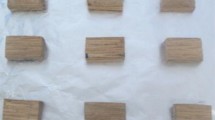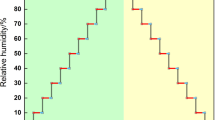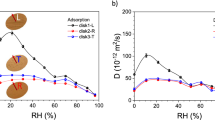Abstract
The water vapour sorption isotherms and sorption kinetics of birch (Betula pendula L) acetylated to different levels have been determined using a dynamic vapour sorption (DVS) apparatus. A DVS instrument was also used to determine the accessible hydroxyl content in the wood samples using deuterium exchange. The results are reported in terms of the reduced equilibrium moisture content (EMCR), in which the moisture content per unit mass of wood substance is used for the calculation. As the level of acetylation of the wood samples increased there was a corresponding reduction in EMCR of the wood samples, which was accompanied by a decrease in hysteresis in the same order. The sorption kinetics were also determined using the DVS and analysed using the parallel exponential kinetics model, in which the sorption kinetics curve is composed of two processes (labelled fast and slow). Using this analysis, it is possible to calculate two pseudo-isotherms associated with the two processes. The sorption isotherm is a composite of the sorption isotherms associated with the fast process water and the slow process water and there are significant differences in behaviour between the two. It is suggested in this paper that the fast process is related to diffusion limited kinetics, whereas the slow process is a relaxation-limited phenomenon. The reduction in accessible OH content due to acetylation was well correlated with the weight gain due to acetylation, although the relationship did not exactly correspond with that theoretically determined.









Similar content being viewed by others
References
Li JZ, Furuno T, Katoh S, Uehara T (2000) Chemical modification of wood without solvents or catalysts. J Wood Sci 46(3):215–221. doi:10.1007/BF00776452
Larsson Brelid P, Simonson R, Bergman O, Nilsson T (2000) Resistance of acetylated wood to biological degradation. Holz Roh Werkst 58:331–337. doi:10.1007/s001070050439
Papadopoulos AN, Hill CAS (2002) The biological effectiveness of wood modified with linear chain carboxylic acid anhydrides against Coniophora puteana. Holz als Roh- und Werkstoff 60:329–332. doi:10.1007/s00107-002-0327-8
Hill CAS, Papadopoulos AN, Payne D (2004) Chemical modification employed as a means of probing the cell-wall micropore of pine sapwood. Wood Sci Technol 37(6):475–488. doi:10.1007/s00226-003-0193-5
Ozmen N, Çetin NS, Tingaut P, Sèbe G (2006) A new route for the functionalisation of wood through transesterification reactions. Eur Polym J 42:1617–1624. doi:10.1016/j.eurpolymj.2006.01.020
Hill CAS (2006) Wood modification: chemical, thermal and other processes. Wiley, Chichester
Xie Y, Hill CAS, Xiao Z, Mai C, Militz H (2011) Dynamic water vapour sorption properties of wood treated with glutaraldehyde. Wood Sci Technol 45:49–61. doi:10.1007/s00226-010-0311-0
Hill CAS (2008) The reduction in the fibre saturation point of wood due to chemical modification using anhydride reagents: a reappraisal. Holzforschung 62:423–428. doi:10.1515/HF.2008.078
Papadopoulos AN, Hill CAS (2003) The sorption of water vapour by anhydride modified softwood. Wood Sci Technol 37:221–231. doi:10.1007/s00226-003-0192-6
Mantanis GI, Papadopoulos AN (2010) The sorption of water vapour of wood treated with a nanotechnology compound. Wood Sci Technol 44:515–522. doi:10.1007/s00226-010-0326-6
Jalaludin Z, Hill CAS, Samsi HW, Husain H, Xie Y (2010) Analysis of water vapour sorption of oleo-thermal modified wood of Acacia mangium and Endospermum malaccense by a parallel exponential kinetics model and according to the Hailwood–Horrobin model. Holzforschung 64:763–770. doi:10.1515/HF.2010.100
Xie Y, Hill CAS, Xiao Z, Jalaludin Z, Militz H, Mai C (2010) Water vapor sorption kinetics of wood modified with glutaraldehyde. J Appl Polym Sci 117:1674–1682. doi:10.1002/app.32054
Salin JG (2010) Problems and solutions in wood drying modelling: history and future. Wood Mat Sci Eng 5:123–134. doi:10.1080/17480272.2010.498056
Pfriem A, Zauer M, Wagenfuhr A (2010) Alteration of the unsteady sorption behaviour of maple (Acer pseudoplatanus L.) and spruce (Picea abies (L.) Karst.) due to thermal modification. Holzforschung 64:235–241. doi:10.1515/HF.2010.029
Engelund ET, Thygesen LG, Svensson S, Hill CAS (2013) A critical discussion of the physics of wood-water interactions. Wood Sci Technol 47:141–161. doi:10.1007/s00226-012-0514-7
Hill CAS, Norton AJ, Newman G (2010) The water vapour sorption properties of Sitka spruce determined using a dynamic vapour sorption apparatus. Wood Sci Technol 44:497–514. doi:10.1007/s00226-010-0305-y
Hill CAS, Ramsay J, Keating BK, Laine K, Rautkari L, Hughes M, Constant B (2012) The water vapour sorption properties of thermally modified and densified wood. J Mater Sci 47(7):3191–3197. doi:10.1007/s10853-011-6154-8
Hill CAS, Keating BA, Jalaludin Z, Mahrdt E (2012) A rheological description of the water vapour sorption kinetics behaviour of wood invoking a model using a canonical assembly of Kelvin–Voigt elements and a possible link with sorption hysteresis. Holzforschung 66(1):35–47. doi:10.1515/HF.2011.115
Sharratt V, Hill CAS, Zaihan J, Kint DPR (2010) Photodegradation and weathering effects on timber surface moisture profiles as studied using dynamic vapour sorption. Polym Degrad Stab 95:2659–2662. doi:10.1016/j.polymdegradstab.2010.07.011
Popescu C-M, Hill CAS (2013) The water vapour adsorption–desorption behaviour of naturally aged Tilia cordata Mill. wood. Polym Degrad Stab 98(9):1804–1813. doi:10.1016/j.polymdegradstab.2013.05.021
Okubayashi S, Griesser UJ, Bechtold T (2004) A kinetic study of moisture sorption and desorption of lyocellfibers. Carbohyd Polym 58:293–299. doi:10.1016/j.carbpol.2004.07.004
Kohler R, Renate D, Bernhard A, Rainer A (2003) A numeric model for the kinetics of water vapour sorption on cellulosic reinforcement fibers. Compos Interfaces 10:255–257. doi:10.1163/156855403765826900
Hill CAS, Norton A, Newman G (2010) Analysis of the water vapour sorption behaviour of Sitka spruce [Picea sitchensis (Bongard) Carr.] based on the parallel exponential kinetics model. Holzforschung 64:469–473. doi:10.1515/HF.2010.059
Xie Y, Hill CAS, Jalaludin Z, Sun D (2011) The water vapour sorption behaviour of three celluloses: analysis using parallel exponential kinetics and interpretation using the Kelvin–Voigt viscoelastic model. Cellulose 18:517–530. doi:10.1007/s10570-011-9512-4
Keating B, Hill C, Sun D, English R, Davies P, McCue C (2013) The water vapor sorption behavior of a galactomannan cellulose nanocomposite film analyzed using parallel exponential kinetics and the Kelvin–Voigt viscoelastic model. J Appl Polym Sci 129(4):2352–2359. doi:10.1002/app.39132
van der Wel GK, Adan OCG (1999) Moisture in organic coatings: a review. Prog Org Coat 37:1–14. doi:10.1016/S0300-9440(99)00058-2
Acknowledgements
This study was performed in the framework of the COST Action FP1006. Carmen-Mihaela Popescu wishes to thank the Royal Society of Edinburgh for funding the visiting fellowship to FPRI, Edinburgh Napier University.
Author information
Authors and Affiliations
Corresponding author
Rights and permissions
About this article
Cite this article
Popescu, CM., Hill, C.A.S., Curling, S. et al. The water vapour sorption behaviour of acetylated birch wood: how acetylation affects the sorption isotherm and accessible hydroxyl content. J Mater Sci 49, 2362–2371 (2014). https://doi.org/10.1007/s10853-013-7937-x
Received:
Accepted:
Published:
Issue Date:
DOI: https://doi.org/10.1007/s10853-013-7937-x




